The Grand Tour
There used to be a tradition among a certain class of English gentlemen that when the firstborn son came of age, he set off on a “Grand Tour” around the cities of Europe. Ostensibly this was to educate him in the classics of art and architecture, but it was also his first and only chance to spread his wings and do some growing up on his own. On his return, he was expected to rejoin Society as a fully formed and well-adjusted individual who had had his fun (and, possibly, sown some wild oats) far from the critical eyes of Polite Society, before taking up the serious business of marriage, children and the family estate.
That era is of course long gone, and I certainly didn’t belong to the titled or monied class, but as an eighteen-year old who had just left home to start out at university, the idea had a rather splendid appeal. I got together with David and Andrew, my closest friends from school, and bought an ‘Interrail’ ticket, available to anyone under the age of 26 and valid for 30 days on any train in the whole of Europe.
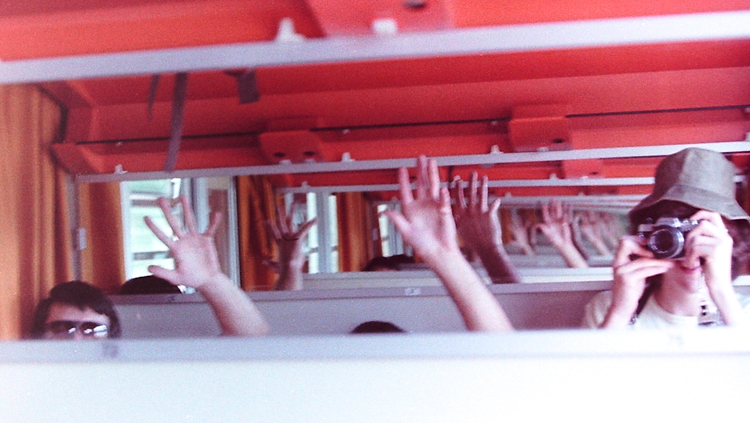
Three men on a train. Finally.
It was our first taste of independent travel, and for me it was the trigger for a lifetime of flitting from place to place, never quite settled, always moving on. This is the tale of that first trip, when, wide-eyed and naive and wet behind the ears, we set out with empty wallets, ridiculously heavy backpacks, and a wide-eyed wonder at the world beyond our borders.
Free train to Loch Ness (Scotland)
Interrail were doing a deal whereby if we purchased the ticket early enough, we received a ‘free ticket to anywhere’. Having never travelled together before, or indeed done any long distance train travel, we decided to do a trial run on the longest train journey available to us over the Easter weekend. After careful perusal of the timetables, we figured out that we just had time to take the train from London in South East England to Inverness in North East Scotland, hike to the famous Loch Ness, camp overnight on its shores, and then turn back around and go home again.
We had a fine old time, and took the opportunity to shake down our hiking and camping gear, and work out what we would take with us when we left for Europe a few months later.
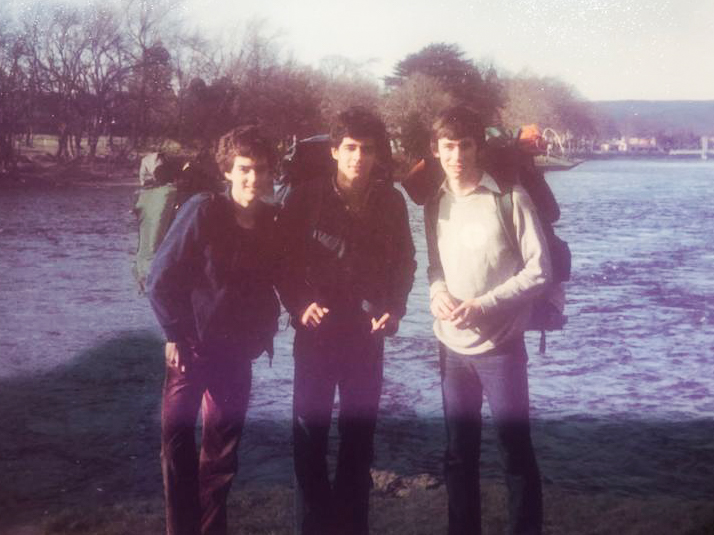
Three men at Loch Ness
London to Dover (England)
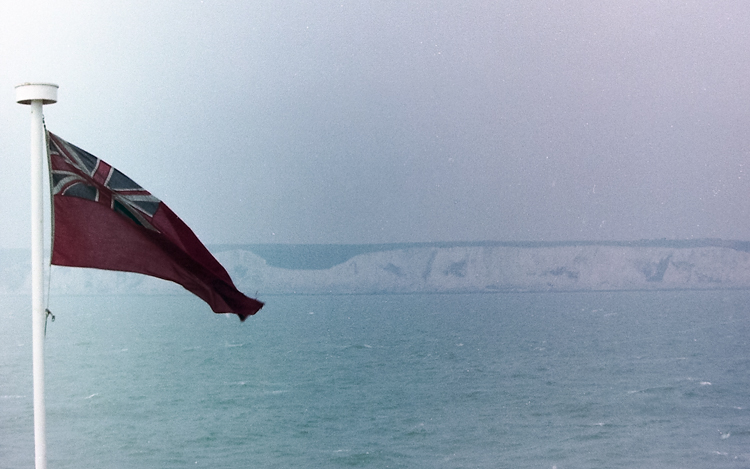
A misty farewell to the White Cliffs of Dover
September soon arrived. Since our Interrail ticket was not valid in the country of purchase, David and I chose the cheap option of a bus to Dover to catch our ferry to France, where we could start our rail journey with an overnight train to Paris. For reasons that remain obscure, Andrew chose not to travel with us, but instead took a train. David and I arrived at the port without any problems, but the ferry to Calais began to board with no sign of Andrew. We already had tickets so we got on the boat anyway. After a look around the decks, we tried to page him on the intercom, but with no result so we had to assume that he was not on board.
Calais (France)
Arriving in Calais with an hour to kill before the next ferry arrived – hopefully with Andrew aboard – we went for a wander. We established that there seemed to be two “cathedrals”, but one was derelict and the other was the town hall, which I later described in my diary as “a technicolor version of Big Ben”
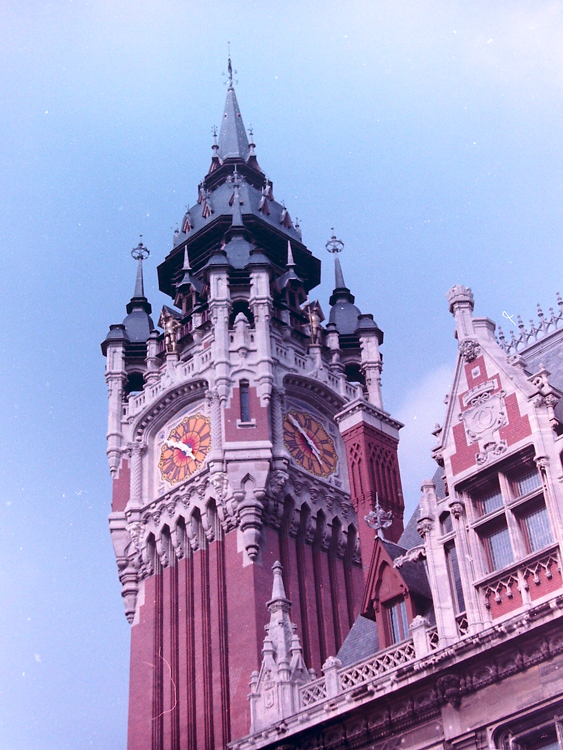
Calais’ Hotel de Ville, our first foreign tourist attraction
We were particularly enamoured by the local treatment of railway crossings. If the barriers were down across the road, it simply meant that the drivers needed to slalom around them without slowing. Pedestrians just ambled across whether the barriers were up or down. On one occasion, there was actually a train parked across the road, presumably waiting for a signal, but the first pedestrian to reach it simply opened a door, stepped into the carriage and out of the door on the other side, the rest of us trooping after.
Andrew wasn’t on the second ferry either.
Remember that this was 1983, well before the invention of mobile phones. We had previously arranged for a relative to act as a message depot if we ever got separated while travelling, so after spending some time trying to understand the labyrinthine French public telephone system, we finally received a message that Andrew was going to be on the second ferry after ours. Apparently he had got on a London bus to the railway station, but the bus had crashed, resulting in him catching the wrong train which went to the wrong side of Dover. When he finally arrived at the ferry port, out of breath from running across the town, they told him that his ticket wasn’t valid until the third ferry.
The problem with this was that he would arrive after the last train had left Calais for the night. We had booked no accommodation because we had intended to sleep on the train to Paris, but the next departure after the ferry was due to arrive didn’t leave until 05:30 the following morning. In fact, once his ferry docked at 20:00 there weren’t any trains leaving for anywhere.
We suddenly recognised Andrew standing at the ferry port. His boat had come in early, and so we all sprinted with our 35lb backpacks to the station and boarded the only remaining train. Apparently it was going to Italy via Switzerland.
Basel (Switzerland)
Andrew and David curled up on their seats, and I chose to stretch out on the floor, which was comfortable enough albeit a little bone-shaking over the points. We had come up with a new itinerary, intending to sleep until our early morning arrival in Basel, and then change for Munich, ultimately bound for the fabled fairy-tale castles of Fűssen. David and I were up and ready and hopped off when the train stopped, but Andrew had found a hot-water basin in a carriage further up and decided that he just had time to have a quick shave.
There were no open borders back in 1983. David and I headed for Customs, where our shiny blue-and-silver passports got us waved through without any attention. From behind the barrier, we noticed that Andrew’s carriage had been disconnected and was being shunted out of the station. Some distance from the platform, he suddenly appeared at a doorway, leaped out and headed back for the station, waving his passport in the air as he ran.
We repaired to the station buffet and broke our fast with coffee and a sausage roll, congratulating ourselves on having finally arrived somewhere more or less as planned and more or less together. As we lingered over coffee and made smug notes in our diaries, our Munich train rolled out of the station.
According to the timetable, it was theoretically possible to catch another Munich train from Basel’s other station, a tram ride away. “Streetcar Number 2” said a helpful uniformed gentleman, but that tram left without us while we were still trying to understand the ticket machine. Eventually Andrew managed to organise the correct change, and we purchased 60 minutes of travel time. A Number 6 passed, then another Number 6, but no Number 2. Suddenly we realised that the Number 6 also went to Badischer Bahnhof, climbed aboard the third one, leaped out at the station and sprinted across a busy street and onto the deserted platform. We’d missed the Munich train by three minutes.
It was still before 09:00 on our first day in Europe. A close perusal of the timetable revealed that, with a couple of changes, we could get to Munich by 17:00. The first train didn’t leave for a while, so we headed to the station bathroom for a wash and, for Andrew, for the second half of his shave.
After a snack of chocolate bars and iced tea, we climbed aboard the 08:36 to Singen. We’d already noticed that some trains were made up of a mixture of rolling stock from different countries, and this was our first Deutsche Bahn carriage, with compartments which boasted seats that converted into couchettes. We resolved to look out for more of these carriages in future.
Lindau (Germany)
We arrived in Singen with 6 minutes to transfer to the Lindau train, and made it with time to spare. We even managed to score another DB carriage, although when David pulled the seat out to form a couchette, the whole thing fell off the wall. As we were trying to quietly put it back together again, we congratulated one another on having, nevertheless, executed a flawless train connection for the first time. Then the ticket inspector arrived and told us that we were in the wrong carriage, and that the train was being split in two and we were at the wrong end of it. We sprinted up the corridor and just managed to jump the gap before our carriage moved off.
Finally, for the first time on this trip, we had a chance to sit quietly and look at the scenery. The train was zig-zagging back and forth between Germany and Switzerland, allowing us to admire the picturesque Swiss villages, partially obscured by low-lying clouds.
In Lindau, we wound our way between groups of souvenir-buying tourists and found a cafe with views across Bodensee (Lake Constance). The lake was very attractive, and although it was warm and sunny, there were thunderous cloud formations rising above the Swiss Alps.
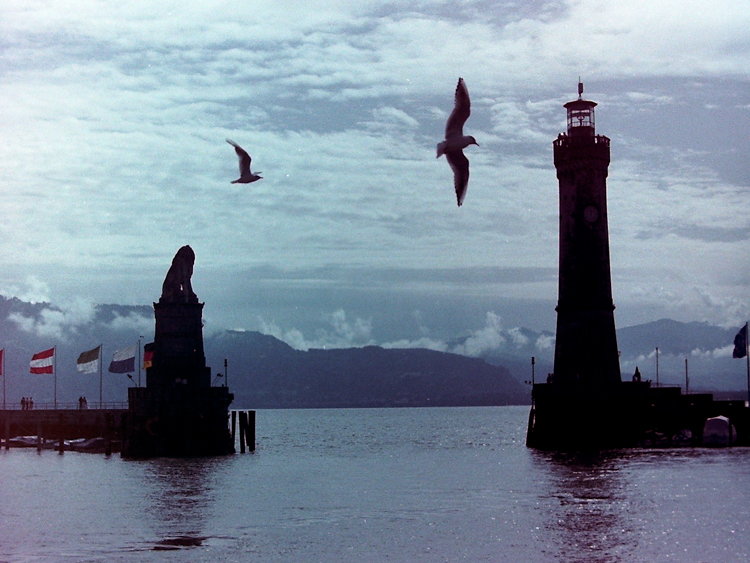
Lindau harbour on Bodensee (Lake Constance)
The cafe prices were rather high for our shallow pockets, but as we sipped our coffee we discovered that they were happy to sell us individual slices of bread, which we could then load up with sliced German sausage that we had purchased earlier from a butcher.
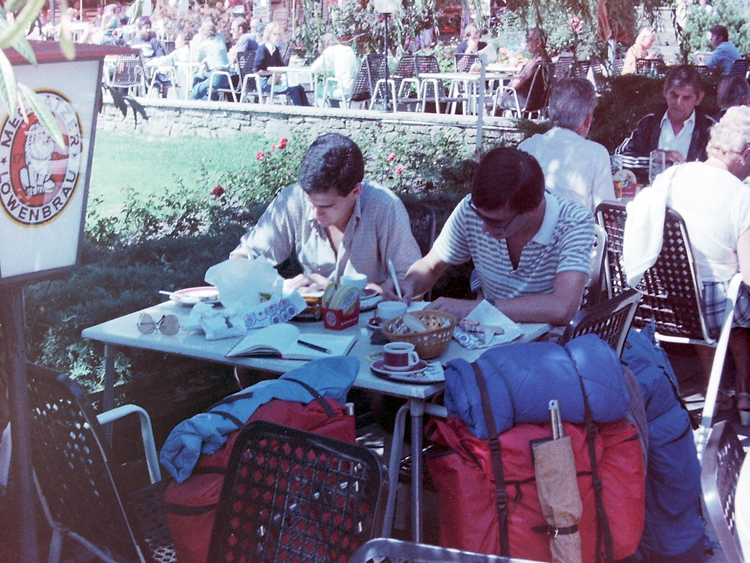
Andrew and David write up their diaries and picnic in a cafe in Lindau
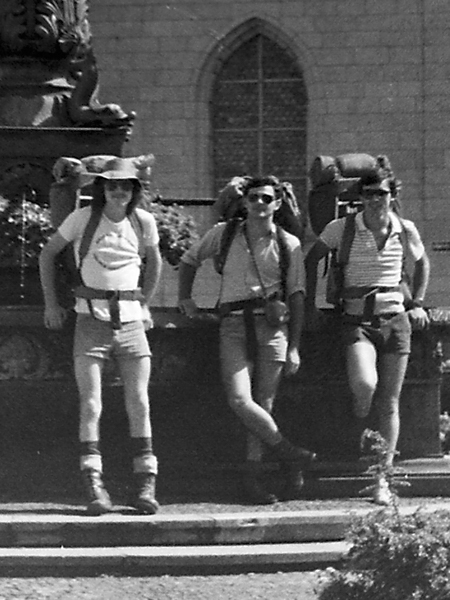
Die drei Freunde in Lindau 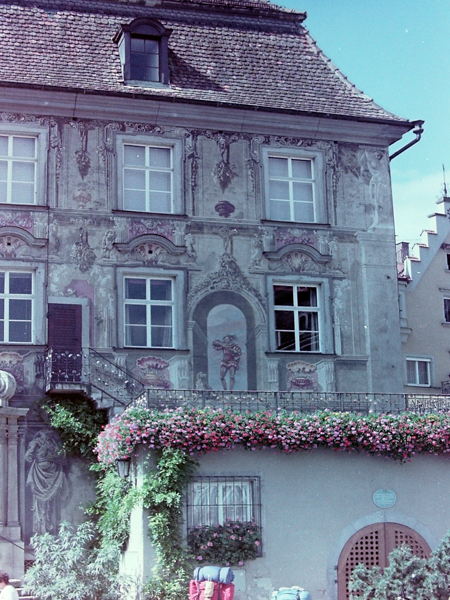
Typical mural on a house in Lindau
Having bought some more supplies, we boarded the correct train at the correct time, and even got a DB carriage. There was nobody else in our six-seater compartment, so we converted all the seats to give ourselves a big flat space to lounge around in, and then – for the first time since leaving England – we dared to take off our boots.
Fűssen / Neuschwanstein (Germany)
Several changes later, including one missed connection and the wrong end of another splitting train, we arrived in the town of Fűssen. I ruefully tallied our record of correctly executed train connections in my diary: a grand total of One. Obviously there was more to this Interrail business than met the eye, but at least we could only improve.
We’d bumped into another pair of Interrailers on the train who already knew the lie of the land, so they took us on a night-time hike to a viewpoint where we could catch a glimpse of the famous castles. There are two of them, one white and one yellow, and we stared up at them spotlit against the pitch-black mountainsides, hanging up there in the stars. This was new, this was different, this was the sort of thing that we wanted to experience. We resolved to climb up to at least one of them in the morning.
While our guides returned to their hostel, we found a flat piece of grass and pitched our tent in pitch darkness, cooking tinned chicken and rice before falling into a deep and satisfied sleep.
We woke and struck camp early; necessarily so, because we had pitched our tent in the grounds of a local hotel, within view of the breakfast room, and we thought it politic to be gone before anybody noticed. We washed up and performed our ablutions down the road in the surprisingly warm waters of the Alpensee, which stands at the very foot of the Alps in a glaciated basin, and began the long climb up to the fairy-tale white castle above.
The path lead through dark and dripping pine forests, hewn out of the mud and edged with railway sleepers, with each step an awkward one-and-a-half strides. Humping metal-framed 16kg rucksacks was a bit of a chore, but finally we reached the top.
Schloss Neuschwanstein (then called Neu Hohenschwangau) was built and inhabited by “Mad King Ludwig” in the late 19th Century. He had spent the happiest days of his youth in his father’s refurbished castle, the gothic yellow Hohenschwangau that we had seen at a distance the night before. Although still rich and powerful, Ludwig’s sovereignty of the kingdom of Bavaria had been removed during a deal with Prussia, so he had it in his mind to create a small private “kingdom” which was more true to his vision of romantic Bavarian tradition. As his power dwindled, he began tinkering with the plans, focussing on the legends of the Knights Templar of the Holy Grail as his model.
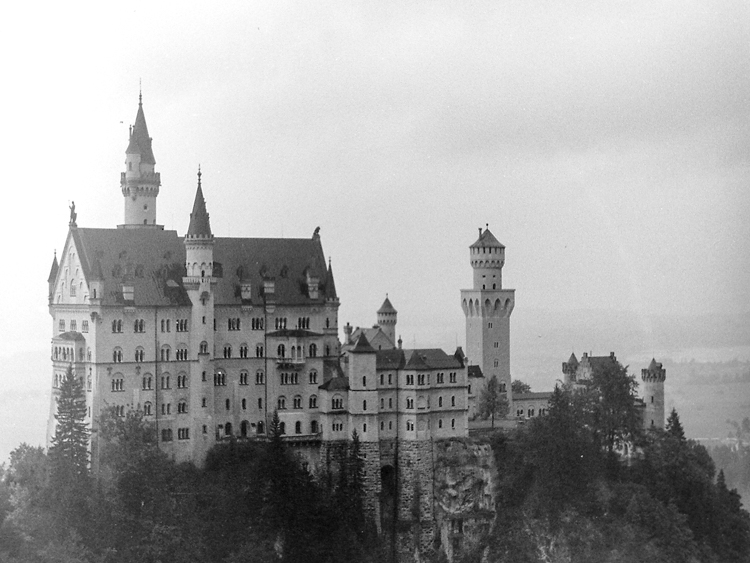
Schloss Neuschwanstein from the Marienbrucke
The result is a candied confection of Gothic splendour mixed with the very latest in 1860s convenience and technology. The walls are painted with spectacular friezes from German legends, separated by buttresses painted in a crazy clash of red, blue, green and yellow. The Gothic carvings in the master bedroom are superb (apparently taking 14 master carvers 4 years to complete), and the chandeliers throughout are modelled on Byzantine crowns in gilt brass with coloured glass gems. The kitchens are massive, and filled with labour-saving devices such as rotisseries driven by smoke turbines.
The difficult but picturesque building site was originally chosen because it could be viewed dramatically from a suspended foot-bridge, the Marienbrűcke, that Ludwig’s father Maximillian had had built as a birthday present for his mountain-climbing consort, Marie. It was a hard climb up to the bridge, but worth it for the views.
Rain had begun to fall as we began our descent, this time running with our backpacks crashing around us at that wretched step-and-a-half, step-and-a-half cadence, but regardless of our efforts, we were soaked to the skin by the time we reached Fűssen. We were out of cash, but one of us had a credit card, so we treated ourselves to a decent Bavarian meal in the touristy Restaurant am Park.
Munich (Germany)
On the way to Munich, we met a girl from Chicago who recommended the Hofbrauhaus am Platzl for its “ethnic atmosphere”, so we dropped in to see if we could get a spot of dinner.
The enormous underground cavern was awash with music and song, packed with beer-mug thumping locals in lederhosen and Tyrolean hats. We fought our way through to an opening on a long trestle table, and tried to attract the eye of one of the impatient serving girls. Even though I spoke reasonable schoolboy German and was theoretically able to communicate effectively, everything had to be shouted over the deafening music and laughter, and the serving system proved incomprehensible. The waitresses, bulging enticingly in our teenage eyes from their traditional dirndls, seemed overwhelmed and somewhat grumpy. Some girls seemed to serve only food, and others only litres of beer, but it was never clear which we were going to get. We did, however, end up with three steins of amber nectar and a single meal of sausage and sauerkraut and sweet pastries, which we shared. Then a nearby party moved away, leaving unfinished beers, so we commandeered them, at which point the waitresses got the idea and kept bringing steins to us, whether we had specifically ordered them or not.

Somewhat blurrily, David and Andrew with litre steins at the Hofbrauhaus
When we eventually staggered out into a riotous evening of street entertainers performing in the Gothic shadows of central Munich, we were perhaps a little tipsy, and somehow managed to lose Andrew on the way back to the station. Luckily we had arranged a meeting point at Platform 15, where we decanted ourselves aboard the night train to Vienna.